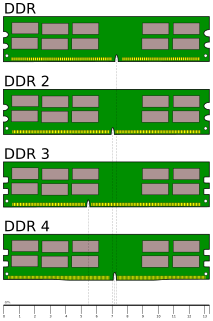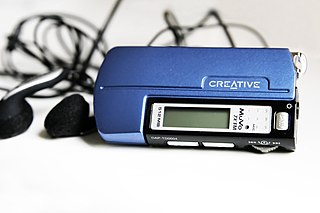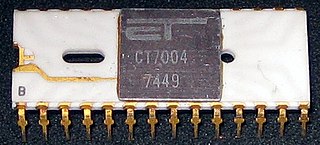 W
W4DX is a 4D film format developed by CJ 4DPlex, a subsidiary of South Korean cinema chain CJ CGV. It allows films to be augmented with various practical effects, including motion seats, wind, strobe lights, simulated snow, and scents. First introduced commercially in 2009, it presents films in both 3D and traditional 2D formats.
 W
WA metal gate, in the context of a lateral metal-oxide-semiconductor (MOS) stack, is just that—the gate material is made from a metal.
 W
WDouble Data Rate Synchronous Dynamic Random-Access Memory, officially abbreviated as DDR SDRAM, is a double data rate (DDR) synchronous dynamic random-access memory (SDRAM) class of memory integrated circuits used in computers. DDR SDRAM, also retroactively called DDR1 SDRAM, has been superseded by DDR2 SDRAM, DDR3 SDRAM, and DDR4 SDRAM, and soon will be superseded by DDR5 SDRAM. None of its successors are forward or backward compatible with DDR1 SDRAM, meaning DDR2, DDR3, DDR4 and DDR5 memory modules will not work in DDR1-equipped motherboards, and vice versa.
 W
WDouble Data Rate 2 Synchronous Dynamic Random-Access Memory, officially abbreviated as DDR2 SDRAM, is a double data rate (DDR) synchronous dynamic random-access memory (SDRAM) interface. It superseded the original DDR SDRAM specification, and was itself superseded by DDR3 SDRAM. DDR2 DIMMs are neither forward compatible with DDR3 nor backward compatible with DDR.
 W
WIn field-effect transistors (FETS), depletion mode and enhancement mode are two major transistor types, corresponding to whether the transistor is in an ON state or an OFF state at zero gate-source voltage.
 W
WA FET amplifier is an amplifier that uses one or more field-effect transistors (FETs). The most common type of FET amplifier is the MOSFET amplifier, which uses metal–oxide–semiconductor FETs (MOSFETs). The main advantage of a FET used for amplification is that it has very high input impedance and low output impedance.
 W
WThe field-effect transistor (FET) is a type of transistor that uses an electric field to control the flow of current. FETs are devices with three terminals: source, gate, and drain. FETs control the flow of current by the application of a voltage to the gate, which in turn alters the conductivity between the drain and source.
 W
WGDDR5 SDRAM, an abbreviation for Graphics Double Data Rate 5 Synchronous Dynamic Random-Access Memory, is a modern type of synchronous graphics random-access memory (SGRAM) with a high bandwidth interface designed for use in graphics cards, game consoles, and high-performance computing. It is a type of GDDR SDRAM.
 W
WHigh Bandwidth Memory (HBM) is a high-speed computer memory interface for 3D-stacked SDRAM from Samsung, AMD and SK Hynix. It is used in conjunction with high-performance graphics accelerators, network devices and in some supercomputers. The first HBM memory chip was produced by SK Hynix in 2013, and the first devices to use HBM were the AMD Fiji GPUs in 2015.
 W
WAn Internet café is a café that provides Internet access to the public. The fee for using a computer is generally charged as a time-based rate.
 W
WA metal gate, in the context of a lateral metal-oxide-semiconductor (MOS) stack, is just that—the gate material is made from a metal.
 W
WThe metal–oxide–semiconductor field-effect transistor, also known as the metal–oxide–silicon transistor, is a type of insulated-gate field-effect transistor that is fabricated by the controlled oxidation of a semiconductor, typically silicon. The voltage of the covered gate determines the electrical conductivity of the device; this ability to change conductivity with the amount of applied voltage can be used for amplifying or switching electronic signals.
 W
WThe metal–oxide–semiconductor field-effect transistor, also known as the metal–oxide–silicon transistor, is a type of insulated-gate field-effect transistor that is fabricated by the controlled oxidation of a semiconductor, typically silicon. The voltage of the covered gate determines the electrical conductivity of the device; this ability to change conductivity with the amount of applied voltage can be used for amplifying or switching electronic signals.
 W
WThe metal–oxide–semiconductor field-effect transistor, also known as the metal–oxide–silicon transistor, is a type of insulated-gate field-effect transistor that is fabricated by the controlled oxidation of a semiconductor, typically silicon. The voltage of the covered gate determines the electrical conductivity of the device; this ability to change conductivity with the amount of applied voltage can be used for amplifying or switching electronic signals.
 W
WThe metal–oxide–semiconductor field-effect transistor (MOSFET, MOS-FET, or MOS FET), also known as the metal–oxide–silicon transistor (MOS transistor, or MOS), is a type of insulated-gate field-effect transistor (IGFET) that is fabricated by the controlled oxidation of a semiconductor, typically silicon. The voltage of the covered gate determines the electrical conductivity of the device; this ability to change conductivity with the amount of applied voltage can be used for amplifying or switching electronic signals. The MOSFET was invented by Egyptian engineer Mohamed M. Atalla and Korean engineer Dawon Kahng at Bell Labs in 1959. It is the basic building block of modern electronics, and the most frequently manufactured device in history, with an estimated total of 13 sextillion (1.3 × 1022) MOSFETs manufactured between 1960 and 2018.
 W
WAn MP3 player is an electronic device that can play MP3 digital audio files. It is a type of digital audio player (DAP), or portable media player. Most players play more than the MP3 file format, such as Windows Media Audio (WMA), Advanced Audio Coding (AAC), Vorbis, FLAC, Speex and Ogg.
 W
WMPEG-2 is a standard for "the generic coding of moving pictures and associated audio information". It describes a combination of lossy video compression and lossy audio data compression methods, which permit storage and transmission of movies using currently available storage media and transmission bandwidth. While MPEG-2 is not as efficient as newer standards such as H.264/AVC and H.265/HEVC, backwards compatibility with existing hardware and software means it is still widely used, for example in over-the-air digital television broadcasting and in the DVD-Video standard.
 W
WThe MPMan music player, manufactured by the South Korean company SaeHan Information Systems, debuted in Asia in March 1998, and was the first mass-produced portable solid state digital audio player.
 W
WPMOS or pMOS logic is a family of digital circuits based on p-channel, enhancement mode metal–oxide–semiconductor field-effect transistors (MOSFETs). In the late 1960s and early 1970s, PMOS logic was the dominant semiconductor technology for large-scale integrated circuits before being superseded by NMOS and CMOS devices.
 W
WA power MOSFET is a specific type of metal–oxide–semiconductor field-effect transistor (MOSFET) designed to handle significant power levels. Compared to the other power semiconductor devices, such as an insulated-gate bipolar transistor (IGBT) or a thyristor, its main advantages are high switching speed and good efficiency at low voltages. It shares with the IGBT an isolated gate that makes it easy to drive. They can be subject to low gain, sometimes to a degree that the gate voltage needs to be higher than the voltage under control.
 W
WScreenX is a panoramic film format which presents films with an expanded, dual-sided, 270-degree screens projected on the walls in a theater. First introduced in 2012, it is created by CJ 4DPLEX, a subsidiary of the CJ CGV group which also created the 4DX motion-theater technology, which, in fact, uses a similar logo and combines both formats, known as "4DX Screen". Co-developed by KAIST, it is considered a "sideways" version of IMAX and a presumed competitor to streaming platforms such as Netflix. In addition to films, the ScreenX theater also shows advertisements filmed or converted for the format.
 W
WSynchronous dynamic random-access memory is any DRAM where the operation of its external pin interface is coordinated by an externally supplied clock signal.
 W
WThundersticks, sometimes known as bambams, are long, narrow plastic balloons that are used as promotional noise makers. The noise is created when two thundersticks are struck together. They are most often used at sporting events.